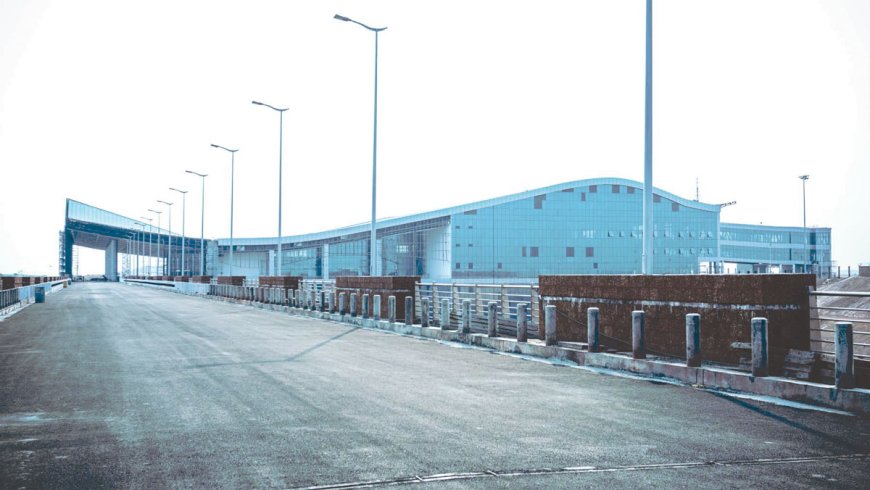A sustainable alternative

With sustainability gaining momentum in construction, pre-engineered buildings (PEBs) are expected to gain momentum in future. In this scenario, Construction Times explores the demand trends, designs and material technologies and the future growth potential in PEB systems.
Growing industrial developments and construction of more warehouses, cargo terminals, stadiums and similar structures are driving the demand for PEB market in India. PEB construction has become the preferred choice for warehouses, retail stores, shopping malls, aviation hangars, recreational projects, and other spaces owing to the myriad benefits it offers.
Evolving trends

India has set for a solid growth in infrastructure development over the last many years. The journey is continuing with the country striving to achieve a significant growth in infrastructure development by 2030. PEB plays an important role in the infrastructure development of the country. “The PEB industry is growing at a CAGR of around 8-9% since last few years. In particular, the industry is not only driven by industrial growth, but also technological advancements in the field, and the need for efficient construction solutions,” says Rahul Timbadia, Chairman & Managing Director, La Tim Group.
PEBs are finding increasing acceptance and demand in manufacturing plants, warehouses, distribution centers, cold storage facilities, medical facilities etc. Besides the traditional applications mentioned above, there is a growing acceptance of PEBs for office spaces, where the demand has significant growth potential due to the trend of rapid urbanization across the country.
Key advantages

The role of Pre-Engineered Steel Buildings in infrastructure development projects is expanding significantly, driven by their numerous advantages and alignment with current industry trends. According to PV Mohan, CEO, Kirby India, some of the key factors contributing to the growth of PEBs in infrastructure development include: speed and efficiency; quick construction; reduced labour requirements; cost-effectiveness; lower costs due to reduced construction time, minimal wastage, and efficient use of materials. This makes them an attractive option for large-scale infrastructure projects.
“Steel buildings have lower maintenance and high durability, sustainability and environmental impact because of energy efficiency, reduction in waste, savings in natural resources, steel as a material having versatility and adaptability to meet diverse applications for a wide range of industry segments, highly customizable with flexibility in design and functionality, etc. All these add up for their growing demand in the infrastructure development projects across India,” he adds.
Demand drivers

The major segments driving the growth of PEB structures and solutions include industries seeking rapid expansion to enhance their production capacities. Key sectors such as warehousing, cement, steel, and automobiles are at the forefront of this demand. According to Sanjay Singhania, Managing Director, EPACK Prefab, there is extensive demand coming from the airport sector, with significant developments in both Greenfield and Brownfield airport expansions. “These segments are leveraging the benefits of PEBs for their efficiency and cost-effectiveness. In fact, our work contributes to the government’s UDAN scheme considerably,” he adds.
New innovations

The role of PEBs in infrastructure development projects is expanding significantly, driven by their numerous advantages and alignment with current industry trends. With the growing adoption of PEB solutions, a lot of innovations are also taking place in the materials, designs and aesthetics of PEB structures. Er Dr Abhay Gupta, Director, Skeleton Consultants Pvt Ltd, elaborates, “New materials of high strength like 450MPa grade, new sections like parallel flange sections for efficiency, new fabrication equipment including welding machines, latest erection technologies, coordinated working through BIM like REVIT & TEKLA platforms, reduced cost of intumescent coatings, etc. are technological innovations leading to steel intensive construction. LGFS is also trending and useful. New IS codes/revised standards help engineers to design better.”
From an aesthetic and durability perspective, La Tim Group offers a range of roofing solutions for PEB structures. Timbadia elaborates, “La Tim offers a wide range of colors and profiles in stone coated roofing sheets that are superior to traditional roofing options by way of better aesthetics, durability, ease and speed of installation, temperature and noise insulation and cost of ownership (sum-total of cost of deployment and maintenance over the product lifecycle).”
Challenges
In the context of PEBs, the demand-supply scenario of steel and other materials presents several challenges that can impact project timelines, costs, and overall feasibility. Some of the key challenges, according to Mohan, are: fluctuating steel prices because of global economic conditions, raw materials costs; supply chain disruptions because of logistics issues & other global factors; quality and standards such as maintaining consistency in quality of steel and complying to regulatory practices both local & international; demand-supply imbalance because of high demand during economic boom, large infrastructure projects, competition from other sectors; and Environmental and sustainability concerns; etc.
According to Dr Gupta, manufacturing industry is growing but demand is increasing. He adds, “Availability of higher-grade material and sections is an issue to some extent but our industry partners are doing their best. However, it targeted that by 2030, per capita steel consumption in India will touch 160 kg against 90 kg as of now. This will need huge manufacturing set ups. At the same time, skilled resources in education and construction sector is a major shortfall and should be addressed. Institutions like INSDAG are putting in a lot of efforts with educational institutions.”
Market opportunities
According to Singhania, there is significant potential and numerous opportunities for PEBs in India, making it a promising market for the near future. Mohan is of the view that PEB industry has got immense potential to grow in the coming years as the PLI scheme would bring in huge investments in the manufacturing sector thereby leading to increase in demand for large scale Grade A warehouses. Other projects such as Atmanirbhar Bharat, Make in India, Industrial Corridors, National Investment & Manufacturing Zones, Gati Shakti Plan, Freight Corridors, etc. will attract huge investments thereby increasing the demand for PEBs.
Dr Gupta sounds optimistic about the opportunities for PEB as he says, “It is quite encouraging. Steel construction is an excellent addition towards growth. It is a green construction also. Significant scrap value is there. I can see much of construction turning to steel as we approach towards 160 kg per capita.”







